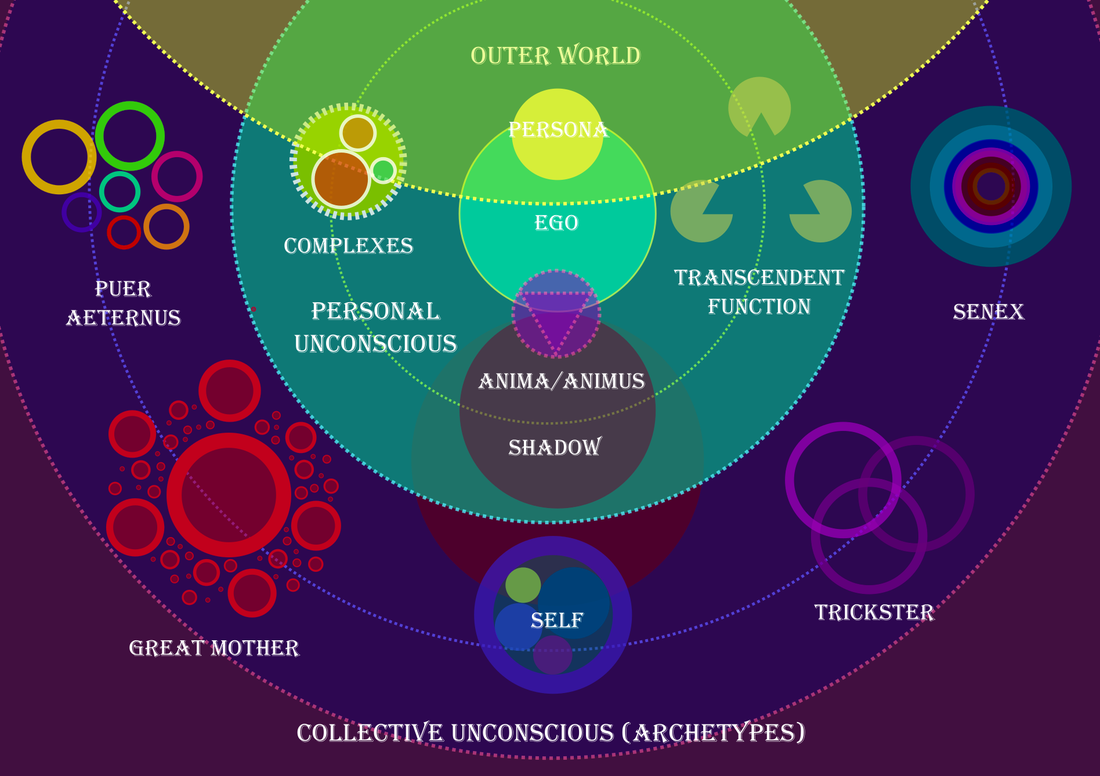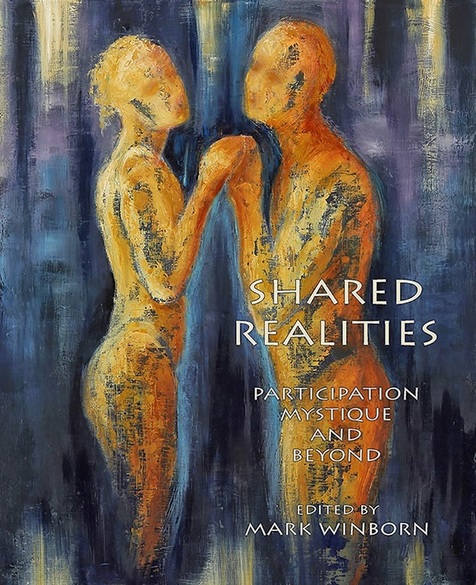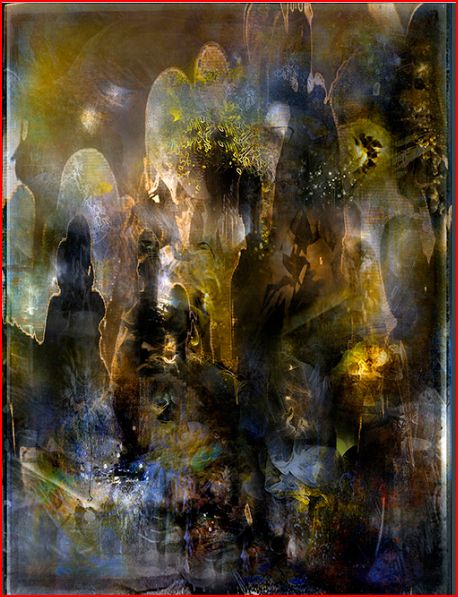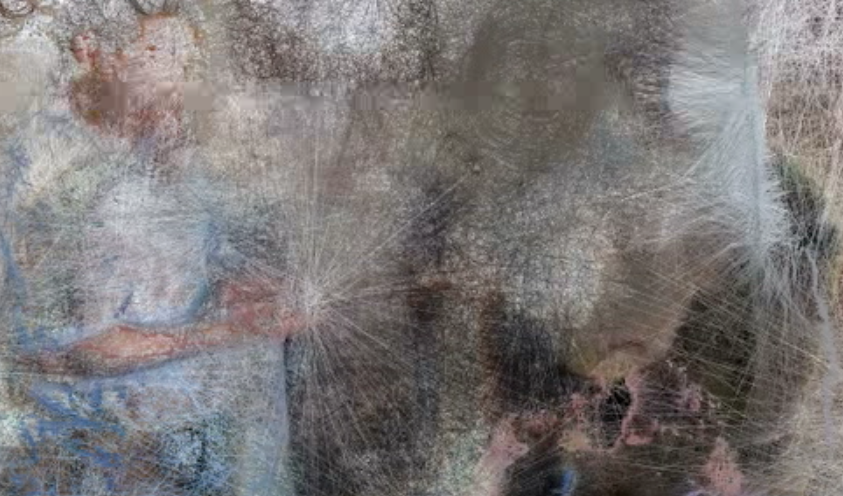PARTICIPATION MYSTIQUE
Projection & Identification
People with a narrow conscious life exteriorize their unconscious, they are continually in participation mystique with other people… if more unconscious things have become conscious to you, then you live less in participation mystique. ~Carl Jung, Visions, para 1184.
Projection & Identification
People with a narrow conscious life exteriorize their unconscious, they are continually in participation mystique with other people… if more unconscious things have become conscious to you, then you live less in participation mystique. ~Carl Jung, Visions, para 1184.
Participation mystique, or mystical participation, refers to the instinctive human tie to symbolic fantasy emanations. This symbolic life precedes or accompanies all mental and intellectual differentiation. The concept is closely tied to that of projection because these contents, which are often mythological motifs, project themselves into situations and objects, including other persons, as readily as we project color into the objects we perceive.
Jung defines participation mystique as one of his basic definitions in Psychological Types, crediting it to Lucien Lévy-Bruhl.
PARTICIPATION MYSTIQUE is a term derived from Lévy-Bruhl. It denotes a peculiar kind of psychological connection with objects, and consists in the fact that the subject cannot clearly distinguish himself from the object but is bound to it by a direct relationship which amounts to partial identity. (Jung, [1921] 1971: paragraph 781).
Jung used the term throughout his writings after Lévy-Brühl's work was published in 1912. Jung referred to it consistently with the French terminology rather than using the English "mystical participation" until Man and His Symbols was published after his death.
The further we go back into history, the more we see personality disappearing beneath the wrappings of collectivity. And if we go right back to primitive psychology, we find absolutely no trace of the concept of an individual. Instead of individuality we find only collective relationship or what Lévy-Bruhl calls participation mystique (Jung, [1921] 1971: par. 12).
Jung's concept of concretism, which is the opposite of differentiating abstraction, is also closely related to participation mystique.
I am reminded of another mental case who was neither a poet nor anything very outstanding, just a naturally quiet and rather sentimental youth. He had fallen in love with a girl and, as so often happens, had failed to ascertain whether his love was requited. His primitive participation mystique took it for granted that his agitations were plainly the agitations of the other, which on the lower levels of human psychology is naturally very often the case. Thus he built up a sentimental love-fantasy which precipitately collapsed when he discovered that the girl would have none of him (Jung, 1966: par. 231).
This is what the distinguished French ethnologist Lucien Lévy-Brühl called a "mystical participation" (Jung et al., 1964:24).
However, Lévy-Brühl actually recanted his theory.
He later retracted this term under pressure of adverse criticism, but I believe that his critics were wrong. It is a well-known psychological fact that an individual may have an unconscious identity with some other person or object (Jung et al., 1964:24).
In Mysterium Coniunctionis (Jung, [1955] 1970:250 note 662), Jung had gone into more detail to defend his own theory in light of the recantation.
Elsewhere in Mysterium Coniunctionis Jung summarily dismisses the objections raised by ethnologists, attributing their objections to lack of knowledge of the unconscious.
Lévy-Bruhl's view has recently been disputed by ethnologists, not because this phenomenon does not occur among primitives, but because they have not understood it. Like so many other specialists, these critics prefer to know nothing of the psychology of the unconscious. (Jung, [1955] 1970:488 note 106). --Wikipedia
References
Jung defines participation mystique as one of his basic definitions in Psychological Types, crediting it to Lucien Lévy-Bruhl.
PARTICIPATION MYSTIQUE is a term derived from Lévy-Bruhl. It denotes a peculiar kind of psychological connection with objects, and consists in the fact that the subject cannot clearly distinguish himself from the object but is bound to it by a direct relationship which amounts to partial identity. (Jung, [1921] 1971: paragraph 781).
Jung used the term throughout his writings after Lévy-Brühl's work was published in 1912. Jung referred to it consistently with the French terminology rather than using the English "mystical participation" until Man and His Symbols was published after his death.
The further we go back into history, the more we see personality disappearing beneath the wrappings of collectivity. And if we go right back to primitive psychology, we find absolutely no trace of the concept of an individual. Instead of individuality we find only collective relationship or what Lévy-Bruhl calls participation mystique (Jung, [1921] 1971: par. 12).
Jung's concept of concretism, which is the opposite of differentiating abstraction, is also closely related to participation mystique.
I am reminded of another mental case who was neither a poet nor anything very outstanding, just a naturally quiet and rather sentimental youth. He had fallen in love with a girl and, as so often happens, had failed to ascertain whether his love was requited. His primitive participation mystique took it for granted that his agitations were plainly the agitations of the other, which on the lower levels of human psychology is naturally very often the case. Thus he built up a sentimental love-fantasy which precipitately collapsed when he discovered that the girl would have none of him (Jung, 1966: par. 231).
This is what the distinguished French ethnologist Lucien Lévy-Brühl called a "mystical participation" (Jung et al., 1964:24).
However, Lévy-Brühl actually recanted his theory.
He later retracted this term under pressure of adverse criticism, but I believe that his critics were wrong. It is a well-known psychological fact that an individual may have an unconscious identity with some other person or object (Jung et al., 1964:24).
In Mysterium Coniunctionis (Jung, [1955] 1970:250 note 662), Jung had gone into more detail to defend his own theory in light of the recantation.
Elsewhere in Mysterium Coniunctionis Jung summarily dismisses the objections raised by ethnologists, attributing their objections to lack of knowledge of the unconscious.
Lévy-Bruhl's view has recently been disputed by ethnologists, not because this phenomenon does not occur among primitives, but because they have not understood it. Like so many other specialists, these critics prefer to know nothing of the psychology of the unconscious. (Jung, [1955] 1970:488 note 106). --Wikipedia
References
- Jung, C.G. ([1921] 1971). Psychological Types, Collected Works, Volume 6, Princeton, N.J.: Princeton University Press. ISBN 0-691-01813-8.
- Jung, C.G. (1966). Two Essays on Analytical Psychology, Collected Works, Volume 7, Princeton, N.J.: Princeton University Press. ISBN 0-691-01782-4.
- Jung, C.G. ([1955] 1970). Mysterium Coniunctionis, Collected Works, Volume 14, Princeton, N.J.: Princeton University Press. ISBN 0-691-01816-2.
- Jung, C.G., et al. (1964). Man and His Symbols, New York, N.Y.: Anchor Books, Doubleday. ISBN 0-385-05221-9.
- Lévy-Bruhl, L. ([1912] 1926). How Natives Think, Translated by Lilian A. Clare, London, 1926.
- Participation mystique A term derived from anthropology and the study of primitive psychology, denoting a mystical connection, or identity, between subject and object. (See also archaic, identification and projection.) [Participation mystique] consists in the fact that the subject cannot clearly distinguish himself from the object but is bound to it by a direct relationship which amounts to partial identity. . . . Among civilized peoples it usually occurs between persons, seldom between a person and a thing. In the first case it is a transference relationship . . . . In the second case there is a similar influence on the part of the thing, or else an identification with a thing or the idea of a thing.["Definitions," CW 6, par. 781.]
[Identity] is a characteristic of the primitive mentality and the real foundation of participation mystique, which is nothing but a relic of the original non-differentiation of subject and object, and hence of the primordial unconscious state. It is also a characteristic of the mental state of early infancy, and, finally, of the unconscious of the civilized adult.[Ibid., par. 741.]
Participation mystique. A term derived from anthropology and the study of primitive psychology, denoting a mystical connection, or identity, between subject and object. (See also archaic, identification and projection.)
[Participation mystique] consists in the fact that the subject cannot clearly distinguish himself from the object but is bound to it by a direct relationship which amounts to partial identity. . . . Among civilized peoples it usually occurs between persons, seldom between a person and a thing. In the first case it is a transference relationship . . . . In the second case there is a similar influence on the part of the thing, or else an identification with a thing or the idea of a thing.[Definitions," CW 6, par. 781.]
[Identity] is a characteristic of the primitive mentality and the real foundation of participation mystique, which is nothing but a relic of the original non-differentiation of subject and object, and hence of the primordial unconscious state. It is also a characteristic of the mental state of early infancy, and, finally, of the unconscious of the civilized adult.[Ibid., par. 741.]
Symbiosis. A psychological state where contents of one's personal unconscious are experienced in another person. (See also projection and soul-image.)
Symbiosis manifests in unconscious interpersonal bonds, easily established and difficult to break. Jung gave an example in terms of introversion and extraversion. Where one of these attitudes is dominant, the other, being unconscious, is automatically projected.
Either type has a predilection to marry its opposite, each being unconsciously complementary to the other. . . . The one takes care of reflection and the other sees to the initiative and practical action. When the two types marry, they may effect an ideal union. So long as they are fully occupied with their adaptation to the manifold external needs of life they fit together admirably.["The Problem of the Attitude-Type," CW 7, par. 80.]
Problems in such relationships typically surface only later in life, accompanied by strong affect.
When the man has made enough money, or if a fine legacy should drop from the skies and external necessity no longer presses, then they have time to occupy themselves with one another. Hitherto they stood back to back and defended themselves against necessity. But now they turn face to face and look for understanding-only to discover that they have never understood one another. Each speaks a different language. Then the conflict between the two types begins. This struggle is envenomed, brutal, full of mutual depreciation, even when conducted quietly and in the greatest intimacy. For the value of the one is the negation of value for the other.[Ibid.]
The ending of a symbiotic relationship often precipitates an outbreak of neurosis, stimulated by an inner need to assimilate those aspects of oneself that were projected onto the partner.
[Participation mystique] consists in the fact that the subject cannot clearly distinguish himself from the object but is bound to it by a direct relationship which amounts to partial identity. . . . Among civilized peoples it usually occurs between persons, seldom between a person and a thing. In the first case it is a transference relationship . . . . In the second case there is a similar influence on the part of the thing, or else an identification with a thing or the idea of a thing.[Definitions," CW 6, par. 781.]
[Identity] is a characteristic of the primitive mentality and the real foundation of participation mystique, which is nothing but a relic of the original non-differentiation of subject and object, and hence of the primordial unconscious state. It is also a characteristic of the mental state of early infancy, and, finally, of the unconscious of the civilized adult.[Ibid., par. 741.]
Symbiosis. A psychological state where contents of one's personal unconscious are experienced in another person. (See also projection and soul-image.)
Symbiosis manifests in unconscious interpersonal bonds, easily established and difficult to break. Jung gave an example in terms of introversion and extraversion. Where one of these attitudes is dominant, the other, being unconscious, is automatically projected.
Either type has a predilection to marry its opposite, each being unconsciously complementary to the other. . . . The one takes care of reflection and the other sees to the initiative and practical action. When the two types marry, they may effect an ideal union. So long as they are fully occupied with their adaptation to the manifold external needs of life they fit together admirably.["The Problem of the Attitude-Type," CW 7, par. 80.]
Problems in such relationships typically surface only later in life, accompanied by strong affect.
When the man has made enough money, or if a fine legacy should drop from the skies and external necessity no longer presses, then they have time to occupy themselves with one another. Hitherto they stood back to back and defended themselves against necessity. But now they turn face to face and look for understanding-only to discover that they have never understood one another. Each speaks a different language. Then the conflict between the two types begins. This struggle is envenomed, brutal, full of mutual depreciation, even when conducted quietly and in the greatest intimacy. For the value of the one is the negation of value for the other.[Ibid.]
The ending of a symbiotic relationship often precipitates an outbreak of neurosis, stimulated by an inner need to assimilate those aspects of oneself that were projected onto the partner.
Projection:
An automatic process whereby contents of one’s own unconscious are perceived to be in others. (See also archaic, identification and participation mystique.)
Just as we tend to assume that the world is as we see it, we naïvely suppose that people are as we imagine them to be. . . . All the contents of our unconscious are constantly being projected into our surroundings, and it is only by recognizing certain properties of the objects as projections or imagos that we are able to distinguish them from the real properties of the objects. . . . Cum grano salis, we always see our own unavowed mistakes in our opponent. Excellent examples of this are to be found in all personal quarrels. Unless we are possessed of an unusual degree of self-awareness we shall never see through our projections but must always succumb to them, because the mind in its natural state presupposes the existence of such projections. It is the natural and given thing for unconscious contents to be projected.["General Aspects of Dream Psychology," ibid., par. 507.]
Projection means the expulsion of a subjective content into an object; it is the opposite of introjection. Accordingly, it is a process of dissimilation, by which a subjective content becomes alienated from the subject and is, so to speak, embodied in the object. The subject gets rid of painful, incompatible contents by projecting them.["Definitions," CW 6, par. 783.]
Projection is not a conscious process. One meets with projections, one does not make them.
The general psychological reason for projection is always an activated unconscious that seeks expression.["The Tavistock Lectures," CW 18, par. 352.]
It is possible to project certain characteristics onto another person who does not possess them at all, but the one being projected upon may unconsciously encourage it.
It frequently happens that the object offers a hook to the projection, and even lures it out. This is generally the case when the object himself (or herself) is not conscious of the quality in question: in that way it works directly upon the unconscious of the projicient. For all projections provoke counter-projections when the object is unconscious of the quality projected upon it by the subject.["General Aspects of Dream Psychology," CW 8, par. 519.]
Through projection one can create a series of imaginary relationships that often have little or nothing to do with the outside world.
The effect of projection is to isolate the subject from his environment, since instead of a real relation to it there is now only an illusory one. Projections change the world into the replica of one’s own unknown face. In the last analysis, therefore, they lead to an autoerotic or autistic condition in which one dreams a world whose reality remains forever unattainable.["The Shadow," CW 9ii, par. 17.]
Projection also has positive effects. In everyday life it facilitates interpersonal relations. In addition, when we assume that some quality or characteristic is present in another, and then, through experience, find that this is not so, we can learn something about ourselves. This involves withdrawing or dissolving projections.
So long as the libido can use these projections as agreeable and convenient bridges to the world, they will alleviate life in a positive way. But as soon as the libido wants to strike out on another path, and for this purpose begins running back along the previous bridges of projection, they will work as the greatest hindrances it is possible to imagine, for they effectively prevent any real detachment from the former object.["General Aspects of Dream Psychology," CW 8, par. 507.]
The need to withdraw projections is generally signaled by frustrated expectations in relationships, accompanied by strong affect. But Jung believed that until there is an obvious discordance between what we imagine to be true and the reality we are presented with, there is no need to speak of projections, let alone withdraw them.
Projection . . . is properly so called only when the need to dissolve the identity with the object has already arisen. This need arises when the identity becomes a disturbing factor, i.e., when the absence of the projected content is a hindrance to adaptation and its withdrawal into the subject has become desirable. From this moment the previous partial identity acquires the character of projection. The term projection therefore signifies a state of identity that has become noticeable.["Definitions," CW 6, par. 783.]
Jung distinguished between passive projection and active projection. Passive projection is completely automatic and unintentional, like falling in love. The less we know about another person, the easier it is to passively project unconscious aspects of ourselves onto them.
Active projection is better known as empathy-we feel ourselves into the other’s shoes. Empathy that extends to the point where we lose our own standpoint becomes identification.
The projection of the personal shadow generally falls on persons of the same sex. On a collective level, it gives rise to war, scapegoating and confrontations between political parties. Projection that takes place in the context of a therapeutic relationship is called transference or countertransference, depending on whether the analysand or the analyst is the one projecting.
In terms of the contrasexual complexes, anima and animus, projection is both a common cause of animosity and a singular source of vitality.
When animus and anima meet, the animus draws his sword of power and the anima ejects her poison of illusion and seduction. The outcome need not always be negative, since the two are equally likely to fall in love.["The Syzygy: Anima and Animus," CW 9ii, par. 30.]
Certainly the split in human nature can be seen in terms of the life and death instinct, but I would not agree that this would be "inorganic from the standpoint of psychology," for to do so would imply that no psychology at all exists in the womb or in the symbolic return to Paradise. The desire for death is often symbolic for a death of ego consciousness to return to soul consciousness, which may strengthen the conscious attitude. There is no desire for life that does not include a desire for death, for we die even as we live.
If we equate the life instinct with ego consciousness and the death instinct with the unconsciousness, the split that Samuels describes can be seen as the splitting of the opposites out of their original unity and a regression as an attempt to restore that unity. Soul consciousness is the reconciling third consciousness that stands in the middle and is connected to both. Soul consciousness is the life and death instincts that are still undifferentiated and exist as one instinct. Thus, it is identical to the function of intuition, and the reason intuition is the primal instinct. Soul is the archetype, intuition is the instinct.
The "preconceived state" that Samuels suggests is "inorganic from a psychological view" is nothing of the kind, because psychological experience would exist in the primal experience of being in the womb in the form of the intuitive function. If the instinct contains the archetype, the soul would also exist in the infant's psyche and could be called psychological. Thus, the origin of the soul would be at conception, when the basic instinct of intuitive matter responds to matter and life begins. To be inorganic would imply that there is no organizational process in the experience of the soul complex, in or out of the womb.
The return to the mother might be a return to the participation mystique of infancy, but not the exact experience of the infant in utero. In this case, the mother's state of psychological being might induce "hell" rather than "heaven," for a state of despair might be shared with the infant. The flow of the ego to soul and back to ego is a natural and essential part of the child's life, not unlike what Fordham describes as integration and deintegration. It is not returning to the soul that creates havoc in the adult or the child, but the inability to arrive there safely and return safely. One way back to soul is through love and another is through fear, which is a perception that "oneness" is missing. In the first reintegration, the mother returns the child to unity by an act of love, by meeting the child's ego demands. If needs are not met on a regular basis, the original unity cannot be experienced in the world, which appears to be essential if relationship is to be a positive experience. The result is a state of limbo for the ego, which fears moving in either direction. This is pathology: Whether in an adult or an infant, the experience is the same. Both long for an experience of the original unity and seek it first in a relationship that will match the inner archetype. Ego is then reinforced by the experience, and consciousness is expanded.
http://sulcus.berkeley.edu/flm/SH/MDL/GAL/galdischapts/galdis.intro#TOC
Identification with the group is a simple and easy path to follow, but the group experience goes no deeper than the level of one’s own mind in that state.
It does work a change in you, but the change does not last.
On the contrary, you must have continual recourse to mass intoxication in order to consolidate the experience and your belief in it.
But as soon as you are removed from the crowd, you are a different person again and unable to reproduce the previous state of mind.
The mass is swayed by participation mystique, which is nothing other than unconscious identity. ~Carl Jung, CW 9i, par 226.
Copyright © 2013-2015, Iona Miller,
All Rights Reserved, Sangreality Trust; GenIsis Genealogy
on all original graphic and written content.
If you mirror my works, pls include the credit and URL LINK for reference.
[email protected]
http://ionamiller.weebly.com
Fair Use Notice
This site contains copyrighted material the use of which has not always been specifically authorized by the copyright owner. We are making such material available in our efforts to advance understanding of environmental, political, human rights, economic, democracy, scientific, and social justice issues, etc. We believe this constitutes a 'fair use' of any such copyrighted material as provided for in section 107 of the US Copyright Law. In accordance with Title 17 U.S.C. Section 107, the material on this site is distributed without profit to those who have expressed a prior interest in receiving the included information for research and educational purposes. If you wish to use copyrighted material from this site for purposes of your own that go beyond 'fair use', you must obtain permission from the copyright owner.
All Rights Reserved, Sangreality Trust; GenIsis Genealogy
on all original graphic and written content.
If you mirror my works, pls include the credit and URL LINK for reference.
[email protected]
http://ionamiller.weebly.com
Fair Use Notice
This site contains copyrighted material the use of which has not always been specifically authorized by the copyright owner. We are making such material available in our efforts to advance understanding of environmental, political, human rights, economic, democracy, scientific, and social justice issues, etc. We believe this constitutes a 'fair use' of any such copyrighted material as provided for in section 107 of the US Copyright Law. In accordance with Title 17 U.S.C. Section 107, the material on this site is distributed without profit to those who have expressed a prior interest in receiving the included information for research and educational purposes. If you wish to use copyrighted material from this site for purposes of your own that go beyond 'fair use', you must obtain permission from the copyright owner.





